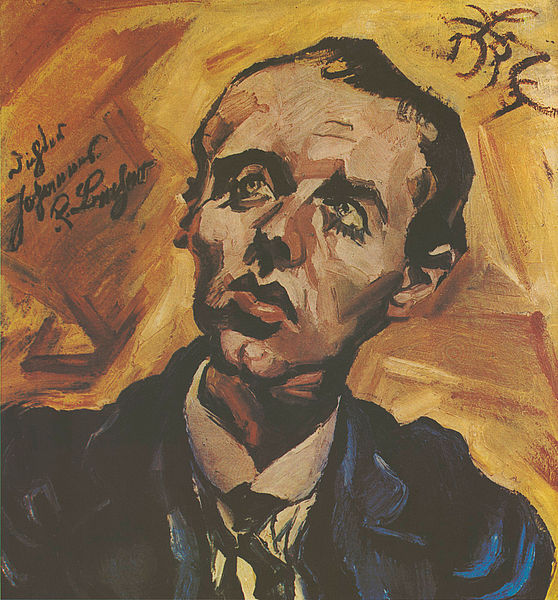
Provenance
1919 Graphisches Kabinett Neumann, Berlin / I.B. Neumann Berlin | from 1919 to at least 1932 Rudolf Ibach, Wuppertal (purchased at Graphisches Kabinett) | until 09/09/1952 Alfred Klinkmüller, Berlin (West) | 09/09/1952 purchase by the Academy of the Arts, Berlin (East)
The friendship between Johannes R. Becher and Ludwig Meidner lasted from 1914 to 1923. They spent nights on end together at Meidner's studio on Motzstraße discussing questions and problems that moved them. Becher was seven years younger but was like family. This was how Meidner reported on it at the Verlag der Künste publishing house in 1962.
As a painter, graphic artist and poet, he was acquainted with many other Expressionist artists and literati and was an important portrait artist of the Weimar Republic. During National Socialism, artistic work was no longer possible for him. Many of his works were shown at the 1937 Entartete Kunst (Degenerate Art) exhibition. In order to escape antisemitic repression, Meidner and his family fled to England in 1939. In 1953, he returned to Germany and tried to resume his career as an artist.


The first indication of a possible previous owner of the portrait of Johannes R. Becher is on the back of the painting, where the abbreviation "IBN" is written by hand. This does not stand for "Johannes-Becher-Nachlass" at the Akademie der Künste, as initially believed, but rather were the initials of Jewish art dealer Israel Ber Neumann, owner of the Graphisches Kabinett in Berlin from 1910. Karl Nierendorf took over the Berlin Kabinett in 1924 after Neumann moved to the USA. The exact same initials are on the back of a self-portrait by Ludwig Meidner in the Nationalgalerie der Staatlichen Museen zu Berlin. Furthermore, the work is depicted in Lothar Brieger's monograph about Ludwig Meidner, which appeared in the series Junge Kunst in 1919, and Neumann is listed as the owner.
The piano maker and art collector Rudolf Ibach (1873–1940) from Wuppertal is said to have bought the painting from I.B. Neumann in the winter of 1918/19, probably during an exhibition at the Graphisches Kabinett. The Ibach piano factory fell into financial difficulties in about 1930. In order to save his company from bankruptcy, Rudolf Ibach sold parts of his art collection. In the current Ibach family archive, there is a security agreement from a bank dating from 1932, which lists the art holdings at that time. The family archive has not yet been fully researched and whether Meidner's work was sold during this period could not be reviewed during the project. The last proof of ownership can be found in an exhibition catalogue from 1932.
He loaned the Becher portrait to the exhibition of Old and New Paintings in Private Ownership at Barmer Kunstverein in January 1932. According to this, the work could have been inherited in 1940 by Ibach's daughter Etta Stangl (1913–1990) and remained in the family collection. This formed the foundation for Galerie Etta und Otto Stangl in 1947, which became one of the most important meeting points for avant garde artists.
The documentation in the inventory book of the Archive of the Academy of the Arts (East) documents a receipt from "Alfred Klinkmüller from Berlin-West for DM 2,550.00" on 9 September 1952. Berlin painter and restorer Alfred (Fred) Klinkmüller (1912–1977) studied with Max Kaus at the Vereinigte Staatsschulen für Freie und Angewandte Kunst (United State Schools for Fine and Applied Arts). His name comes up in connection with the recovery of cultural assets after the Second World War. The Fritz Cremer Archive of the Akademie der Künste reveals that, in 1945, Klinkmüller secured some of the works by Cremer from the Berliner Hochschule für Bildende Künste (Berlin Academy of Fine Arts). With Klinkmüller's support, these were exhibited at Galerie Franz in Berlin in 1947. Purchase files from the in-house archives dating from 1951 provide evidence of artworks offered through Klinkmüller.
In the Johannes R. Becher Archive, there is a letter from Rudolf Engel, director of the German Academy of Arts, dating from 1952, in which Becher indicated that the Academy attempted for many years to purchase his young portrait of the painter Meidner but failed time and time again. When Alfred Klinkmüller acquired the work and whether he simply brokered the purchase on commission for the Academy in 1952 remains unknown. It is possible that it came into his possession in the context of "recovering" cultural assets in the post-war period through connections with the Zentralstelle zur Erfassung und Pflege von Kunstwerken (Centre for the documentation and care of artworks) located at the Office of the Magistrate of Greater Berlin.